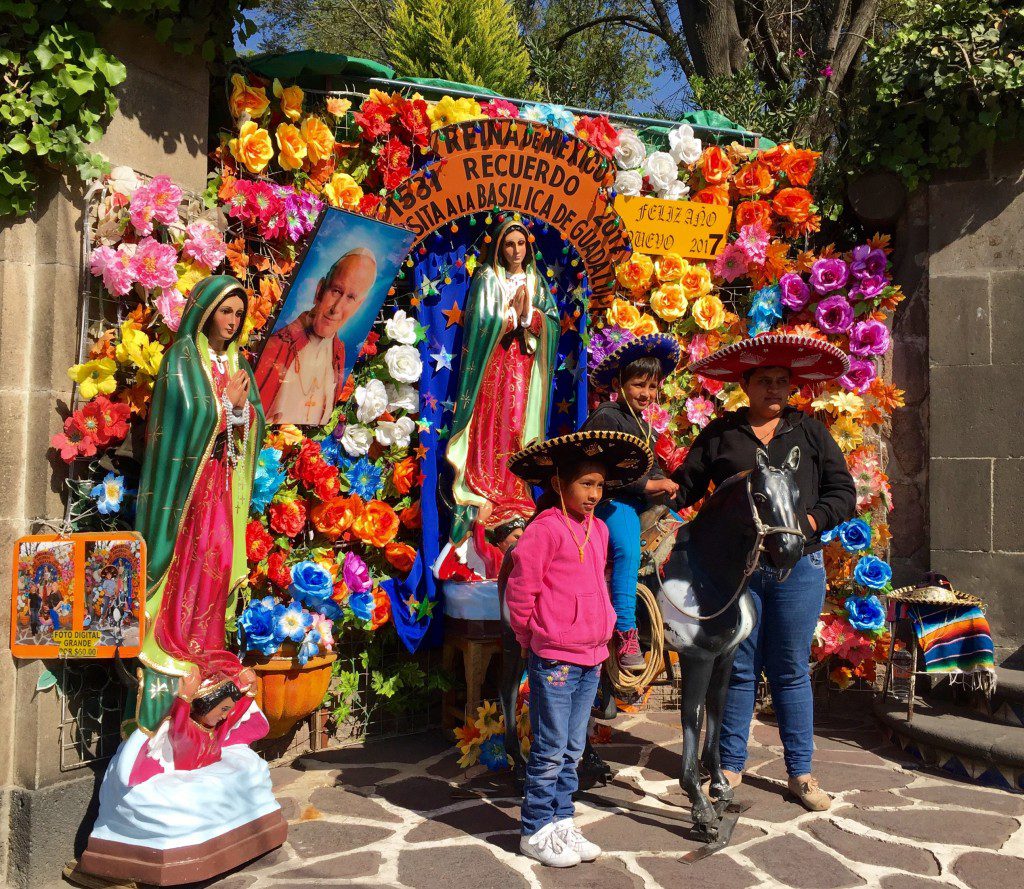
Those of you who’ve followed my blog for awhile know that I have a special fondness for the Virgin Mary and have visited her shrines around the world. So you can imagine how pleased I was to finally get the chance to visit one of her best-known holy sites: the Shrine of Our Lady of Guadalupe in Mexico City.
You might think this is quite a leap from the Aztec and Mayan landmarks that I’ve been writing about in the past half-dozen posts. But there’s actually a direct line of connection, for Our Lady of Guadalupe has deep roots in the pre-Christian history of Mesoamerica.
Her story begins in 1531, when a devout, poor Indian man named Juan Diego (an Aztec convert to Christianity) received a vision of the Virgin Mary on Tepeyac Hill near what is now Mexico City—the same hillside that had formerly been a worship site for the Aztec goddess Tonantzin.
Mary told him that she wanted to have a church built in her honor on that spot. Juan reported the vision to his bishop, who asked for a sign of its truth. Juan returned to the spot where he’d seen Mary and asked for her help in proving his claim to the bishop. Mary filled his apron (a garment known as a tilma) with Castilian roses, which were miraculously blooming despite the fact that such flowers did not grow in Mexico during that period.
“Show them only to the bishop,” she said.
When Juan did so, another miracle occurred: the image of Mary was imprinted upon Juan’s tilma. (This is the picture that’s been reprinted countless times.)
The story of Juan Diego became a powerful sign of God’s grace being given to the native peoples of the New World. Not only did Mary appear to a poor Indian, but the image of her on his tilma had brown skin. Devotion to her quickly spread throughout Mesoamerica.
Today the Virgin of Guadalupe is the patroness of the Americas. She’s particularly well-loved in Mexico, where even those who aren’t religious appreciate her symbolic power (for example, her image was used in the campaign for Mexican independence in the early 19th century).
This shrine, which draws millions of pilgrims each year, is one of the most-visited holy sites in the world. The most popular day to visit is December 12, the feast day of the Virgin of Guadalupe, which is held on the anniversary of Juan Diego’s first vision.
I visited the shrine on a sunny, pleasantly warm February day. There were only a few hundred people there, but it was clear that this site can accommodate many thousands of visitors.

An open-air, circular basilica adjoins a huge square. Inside this building is the apron of Juan Diego that’s imprinted with the image of Mary. Made of cactus fibers, it’s kept in a gilded frame behind its altar. People view the tilda from a slowly moving sidewalk just below, which ensures that everyone gets the chance to see it but that they don’t linger too long.
I went back and forth on that moving sidewalk several times, gazing upwards all the while. Though time has somewhat faded the image, it’s still clearly visible. It was a thrill to see the familiar, beloved image up close, and I also loved the quirky way modern technology intertwines with holiness at this shrine.
Entire books have been written about the symbolism of the Virgin of Guadalupe. On her cloak are stars that are said to mimic the pattern of the constellations visible at the hour of her first apparition to Juan Diego. Under her feet is a crescent moon, which may symbolize the old Aztec religion or be a reference to a line from the Book of Revelation about a woman who has the moon under her feet (though certainly the moon is a common symbol in many religions, and one can interpret it in a wide variety of ways).

After seeing the tilda, I wandered through the shrine’s beautifully landscaped campus, which reminded me of Lourdes, the great healing shrine in France. Both are built to accommodate many thousands of pilgrims.
But while Lourdes is full of those seeking healing—-people in wheelchairs, on crutches, and with the bald heads of chemotherapy patients-—this shrine felt celebratory. I saw many families carrying babies dressed in baptism finery, with rows upon rows of ruffles and lace. Nearly everyone was dressed in brightly covered outfits, and everybody seemed in a good mood.

In addition to the modern-style basilica, there’s an older church that was built between 1695-1709. It continues to be a place for prayer and devotion, though the shrine’s major services are now held in the newer basilica.

The hill where Juan Diego received his visions can still be climbed. A pilgrim’s path bordered by lush gardens winds to its top, where another, smaller church stands. This sanctuary is guarded by a most impressive cadre of archangels, who certainly look strong enough to keep away any intruders.
On feast days, it’s traditional that people approach the shrine on their knees as a sign of devotion. I didn’t see anyone doing so, but I could sense the devotion that filled people’s hearts at this beloved holy site.
After visiting the shrine, the Virgin of Guadalupe was on my radar throughout Mexico. I saw her everywhere-—in simple roadside shrines and in shops, on T-shirts and candles and hanging from the rearview mirror of taxi cabs. It made me love Mexico all the more.
But I also saw Mary through the eyes of my Mayan and Aztec tours. I could see the ways in which the mother goddesses of these cultures influenced the devotion to the Virgin Mary today. Religions, after all, are great recyclers of themes, stories, and traditions.
And I love the way that the Virgin Mary has found a home in places throughout the world, including this city where the Aztecs once ruled.
Stay in touch! Like Holy Rover on Facebook:












